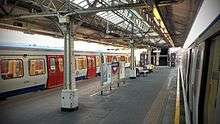Hammersmith tube station (Hammersmith & City and Circle lines)
| Hammersmith | |
|---|---|
|
Station entrance | |
 Hammersmith Location of Hammersmith in Greater London | |
| Location | Hammersmith |
| Local authority | London Borough of Hammersmith and Fulham |
| Managed by | London Underground |
| Number of platforms | 3 |
| Accessible | Yes[1] |
| Fare zone | 2 |
| OSI | Hammersmith (Piccadilly and District lines)[2] |
| London Underground annual entry and exit | |
| 2013 |
|
| 2014 |
|
| 2015 |
|
| 2016 |
|
| Key dates | |
| 1864 | Opened |
| 1868 | Resited |
| 1 February 1960 | Goods yard closed[4] |
| Other information | |
| Lists of stations | |
| External links | |
| WGS84 | 51°29′39″N 0°13′30″W / 51.494277°N 0.225037°WCoordinates: 51°29′39″N 0°13′30″W / 51.494277°N 0.225037°W |
|
| |
Hammersmith is a London Underground station in Hammersmith. It is the western terminus of the Circle and Hammersmith & City lines. The station is in Travelcard Zone 2 and is a short walk from the station of the same name on the Piccadilly and District lines. The two stations are separated by Hammersmith Broadway. They are about 60 m (200 ft) apart door to door, although the positions of the pedestrian crossings on the Broadway makes it seem much longer on foot.[5] The Circle line has served Hammersmith since 13 December 2009. By June 2011 all of the platforms had been lengthened to accommodate the new and longer trains of the S Stock that first entered service on the Hammersmith and City Line from the beginning of July 2012. These new trains are seven cars in length instead of the six cars of C Stock that previously operated.
History

The present station is situated on Beadon Road and opened on 1 December 1868, replacing the original station slightly north of here which opened on 13 June 1864 when the Metropolitan Railway's extension was built from Paddington.
The Metropolitan Railway operated a service from Hammersmith to Richmond from 1877 over the lines of the London and South Western Railway (lines that are now part of the modern District line) from a junction just north of this station via an adjacent station at Hammersmith (Grove Road) and a viaduct connection to Ravenscourt Park. Part of this viaduct is still visible from District and Piccadilly line trains west of the Hammersmith station on those lines. The extension closed on 31 December 1906 shortly after the introduction of electric trains on the line.
Depot
The Hammersmith depot is located just outside the station. It is used for general maintenance and storage of the S7 Stock trains which operate on the Hammersmith & City line.
On 29 August 1991, three incendiary devices, attributed to the IRA, were discovered under a seat at the depot. There were no injuries.[6]
Connections
London Buses routes 9, 10, 27, 33, 72, 190, 209, 211, 220, 266, 267, 283, 295, 391, 419, 485, H91 and night route N9, N11 and N97 serve the station and the nearby bus station.
In popular culture
The station appears in the film Adulthood (2008), as well as an earlier version of the music video for Lily Allen's "LDN". Lily enters the station and boards a train with her red Raleigh Chopper bicycle, alighting at Ladbroke Grove station. The station also appears in the music video of "Bravo Lover" by Taiwanese pop singer Jolin Tsai.
See also
- Hammersmith tube station (Piccadilly and District lines)
- Hammersmith Grove Road, a third station that used to exist adjacent to the Hammersmith and City Line station on the L&SWR line through Shepherd's Bush to the West London Line.
References
- ↑ "Step free Tube Guide" (PDF). Transport for London. Archived (PDF) from the original on 3 June 2015.
- ↑ "Out of Station Interchanges" (XLS). Transport for London. May 2011. Archived from the original on 20 October 2012.
- 1 2 3 4 "Multi-year station entry-and-exit figures" (XLS). London Underground station passenger usage data. Transport for London. March 2017. Retrieved 28 May 2017.
- ↑ Hardy, Brian, ed. (March 2011). "How it used to be - freight on The Underground 50 years ago". Underground News. London Underground Railway Society (591): 175–183. ISSN 0306-8617.
- ↑ See here for a close-up map. The north of the two roundels is the Hammersmith & City and Circle lines station, the south one is the Piccadilly and District lines station.
- ↑ "Terrorist Incidents". Hansard. 4 March 1996. Written Answers cc51–62W. Retrieved 9 May 2016.
External links
| Wikimedia Commons has media related to Hammersmith tube station (Hammersmith & City Line). |
- "Photographic Archive". London Transport Museum. Archived from the original on 2008-03-18.
| Preceding station | Following station | |||
|---|---|---|---|---|
| Terminus | Circle line | |||
| Hammersmith & City line | towards Barking |
|||
| Former service | ||||
| Preceding station | Following station | |||
| Terminus | Metropolitan line Hammersmith branch (1864-1914) | towards Paddington |
||
| Metropolitan line Hammersmith branch (1914-1990) | towards Paddington |
|||